The Most Versatile Indicator: The Humble Moving Average
Investopedia is partnering with CMT Association on this newsletter. The contents of this newsletter are for informational and educational purposes only, however, and do not constitute investing advice. The guest authors, which may sell research to investors, and may trade or hold positions in securities mentioned herein do not represent the views of CMT Association or Investopedia. Please consult a financial advisor for investment recommendations and services.
The Most Versatile Indicator: The Humble Moving Average
Albert Einstein famously said, “Everything should be made as simple as possible, but not simpler.” This thought directly extends to market analysis and may be necessary for success. Open any charting software, and you will be presented with a never-ending list of technical indicators alongside fundamental and economic data. Understanding what tools to use is critical in building a simple, consistent, and efficient market routine.
To stay in step with Einstein’s insistence on simplicity, let’s take a moment to reflect on one of the simplest yet most versatile indicators – the humble moving average.
Whether you’re a technical analyst, a fundamental investor, or someone looking to make informed decisions, the moving average can provide invaluable insights.
Three Key Ways to Leverage Moving Averages
Despite its simplicity, the moving average can be leveraged in three key ways to provide a wealth of information and insights. By understanding how to interpret moving averages, investors can gain a deeper understanding of market dynamics and make more informed investment decisions.
Support and Resistance
One fundamental way to leverage moving averages is to use them as indicators of support and resistance levels. By analyzing how prices interact with moving averages, investors can identify potential levels where the price may reverse its direction, providing valuable insights for both entry and exit strategies.
Trend Identification
Moving averages serve as effective tools for identifying trends in the market. By analyzing the position of the price relative to the moving average, investors can determine whether the market is in an upward or downward trend, enabling them to align their trading or investment strategies accordingly.
Extension as an Oscillator
Additionally, moving averages can be used as oscillators to gauge the extent to which prices deviate from the average. This provides valuable insight into overbought or oversold conditions, helping investors identify potential reversal points and make informed decisions about market entries or exits.
Choosing the Right Moving Average Length
The choice of moving average length depends on the investor’s goals, holding period, and the characteristics of the stock or market being analyzed. Generally, the 8-day or 10-day simple moving average is suitable for short-term/day traders, the 21-day exponential moving average caters to swing traders, the 50-day or 10-week moving average is preferred by growth-oriented investors, and the 200-day or 40-week moving average is more appropriate for longer-term, value-focused investors.
It’s important to note that there is no one-size-fits-all approach, and the most effective moving average strategy often involves a combination of different time frames and types of moving averages, tailored to the investor’s specific needs and market conditions.
Practical Examples: Applying Moving Averages
Let’s explore some real-world examples of how moving averages can be utilized in various market scenarios:
INVESCO QQQ TRUST SERIES (QQQ)
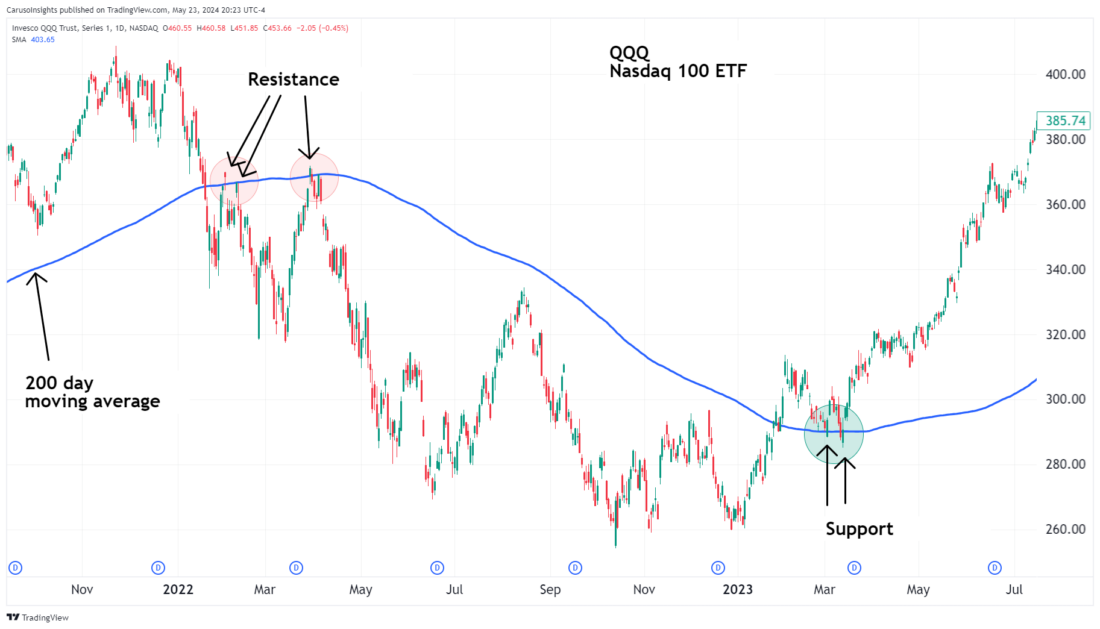
During the bear market of 2022, the QQQ, which tracks the NASDAQ 100 index, encountered significant resistance at the 200-day moving average. This moving average acted as a clear level of overhead resistance, highlighting the importance of this indicator in identifying potential turning points in the market. Once the market bottomed and began an uptrend, the 200-day moving average served as support.
SEA LIMITED (SE)

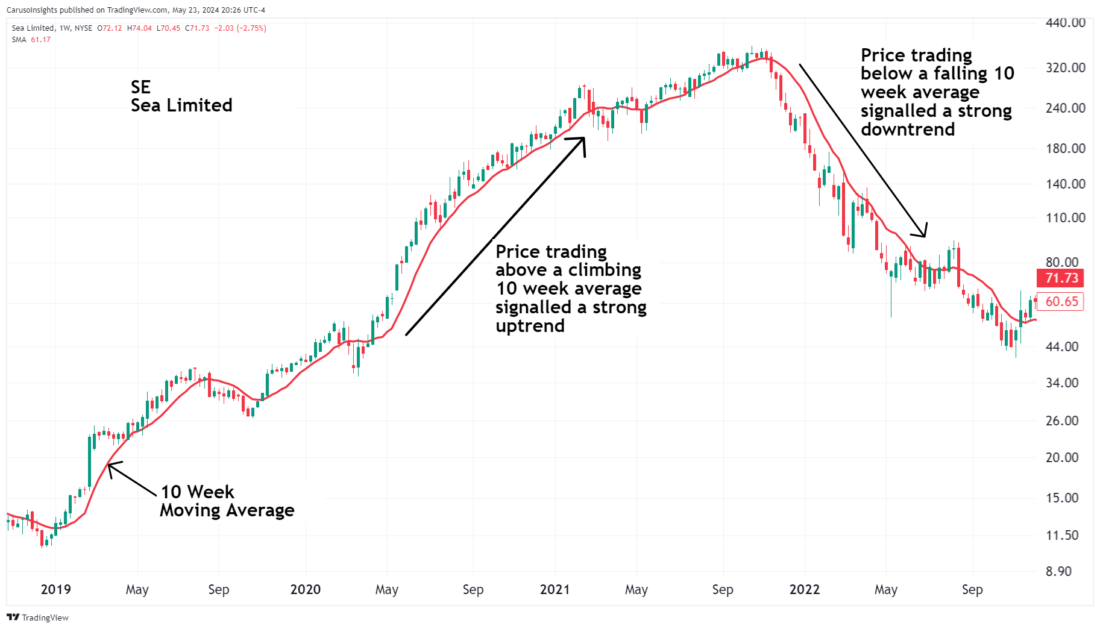
In the aftermath of the COVID-19 pandemic, SE, a leading e-commerce and gaming company, experienced a remarkable bull run. By maintaining its position above a rising 10-week moving average, SE provided a clear bullish trend-following signal, allowing investors to capitalize on the persistent upward momentum.
Conclusion: Embracing the Power of Moving Averages
The humble moving average is a powerful tool that can provide a wealth of information to investors, from identifying support and resistance levels to determining the prevailing trend and managing risk. By understanding the various ways in which moving averages can be utilized, investors can enhance their decision-making process, optimize their risk-to-reward ratios, and navigate the financial markets with greater confidence and success.
Whether you’re a technical analyst, a fundamental investor, or simply someone looking to make informed decisions about your investments, the moving average is a simple yet highly effective tool that deserves a prominent place in your analytical arsenal.
About This Week’s Author
Matthew Caruso, CFA, CMT is a member of the CMT association, having previously served as the president of CMT Canada. As a professional investor and former market-maker, he boasts an impressive track record, including holding the 9-month record in the US Investing Championship. Matthew’s expertise extends to Caruso Insights, a dedicated service aimed at educating investors on constructing and refining high-growth investment strategies. To explore his insights further, visit Carusoinsights.com.
——————————————————
Originally posted on May 24th, 2024
Disclosure: Investopedia
Investopedia.com: The comments, opinions and analyses expressed herein are for informational purposes only and should not be considered individual investment advice or recommendations to invest in any security or to adopt any investment strategy. While we believe the information provided herein is reliable, we do not warrant its accuracy or completeness. The views and strategies described on our content may not be suitable for all investors. Because market and economic conditions are subject to rapid change, all comments, opinions and analyses contained within our content are rendered as of the date of the posting and may change without notice. The material is not intended as a complete analysis of every material fact regarding any country, region, market, industry, investment or strategy. This information is intended for US residents only.
Disclosure: Interactive Brokers
Information posted on IBKR Campus that is provided by third-parties does NOT constitute a recommendation that you should contract for the services of that third party. Third-party participants who contribute to IBKR Campus are independent of Interactive Brokers and Interactive Brokers does not make any representations or warranties concerning the services offered, their past or future performance, or the accuracy of the information provided by the third party. Past performance is no guarantee of future results.
This material is from Investopedia and is being posted with its permission. The views expressed in this material are solely those of the author and/or Investopedia and Interactive Brokers is not endorsing or recommending any investment or trading discussed in the material. This material is not and should not be construed as an offer to buy or sell any security. It should not be construed as research or investment advice or a recommendation to buy, sell or hold any security or commodity. This material does not and is not intended to take into account the particular financial conditions, investment objectives or requirements of individual customers. Before acting on this material, you should consider whether it is suitable for your particular circumstances and, as necessary, seek professional advice.
Disclosure: ETFs
Any discussion or mention of an ETF is not to be construed as recommendation, promotion or solicitation. All investors should review and consider associated investment risks, charges and expenses of the investment company or fund prior to investing. Before acting on this material, you should consider whether it is suitable for your particular circumstances and, as necessary, seek professional advice.






















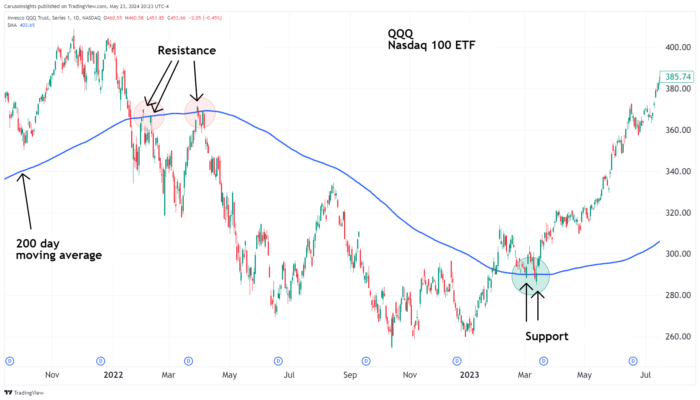





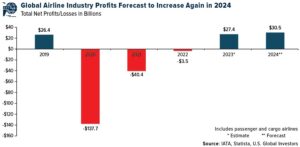



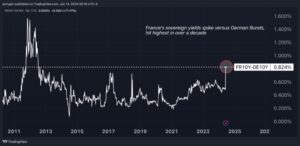
Join The Conversation
If you have a general question, it may already be covered in our FAQs. If you have an account-specific question or concern, please reach out to Client Services.